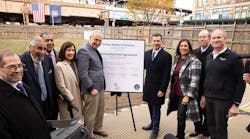OP-ED: PANYNJ's $10 billion funding package for new midtown bus terminal isn't real
You can learn a great deal about the priorities of our elected officials by what they say and don't say when it comes to delivering funding for transportation projects. During the past two weeks, Senate Majority Leader and Senior New York Sen. Charles Schumer (D-NY) and Sen. Kirsten Gillibrand (D-NY), joined by New York Gov. Kathy Hochul and others, announced federal funding of $1.3 billion toward advancing the $1.6 billion East River Tunnel reconstruction, $1.3 billion toward the $3.1 billion Metropolitan Transportation Authority (MTA) Metro-North Railroad Bronx East Penn Station Access, $3.4 billion toward the $7.7 billion New York City (NYC) Transit Second Avenue Subway Phase 2 and $3.8 billion toward Amtrak's $16.8 billion Gateway Tunnel (for two new tunnels plus rehabilitation of two existing Hudson River tunnels connecting New Jersey with Penn Station) projects.
Not a dime as a down payment to pay for any additional preliminary or final design and engineering to advance the proposed $10 billion mid town Manhattan 42nd Street Port Authority of New York and New Jersey (PANYNJ) Bus Terminal. The project has still yet to obtain permission for admission into the Federal Transit Administration (FTA's) Capital Investment Grant (CIG) New Starts Core Capacity Full Funding Grant Agreement (FFGA) national competative discretionary grant program. It appears Schumer, Gillibrand and Hochul, by their actions, or in this case inaction, have clearly indicated no interest in supporting any advancement of this project.
Finding the funding to pay for the new proposed $10 billion PANYNJ midtown Manhattan Bus Terminal is still in limbo. The price tag has grown from $7 to $10 billion over recent years. It could easily increase by several billion more before completion.
Cost estimates would have to be refined, as progress proceeds beyond the planning and environmental phases into real and final design efforts. History has shown estimated costs for construction usually trend upwards as projects mature toward 100 percent final design. Progression of final design refines the detailed scope of work necessary to support construction. The anticipated final potential cost would never be known until completion. Costs would be further refined by award of construction contracts, followed by any unforeseen site conditions and change orders to the base contracts during the course of construction. This will be followed by beneficial use, completion of inspection, acceptance and contract punch list items, receipt of asset maintenance plans, followed by release of retain age and final payment to the contractor(s).
The approved PANYNJ 2017 - 2026 10-year $32 billion Capital Plan provided only $3.5 billion toward construction of the new $10 billion 42nd Street Bus Terminal. The $70 million planning study started in 2019 was just the first down payment. It has assisted in laying the ground work for compliance with the federal NEPA environmental review process. A positive NEPA finding from the federal Environmental Impact Statement (EIS) anticipated from the FTA in 2023 has still not happened. With less than five weeks to go, who knows if this critical interim milestone will not be meet until some time in 2024.
Several more years still be needed for completion of final design and engineering for a project of this size before construction bids could be advertised. PANYNJ was not granted admission by the FTA to enter the CIG New Starts or Core Capacity programs for fiscal year 2024. Without full funding in place, this makes the promised 2024 start of construction date unrealistic. There are many other transit agencies around the nation also seeking FTA funding under these programs. No one can predict the final cost and completion date for the new bus terminal.
The Port Authority is counting on the sale of air rights for up to four high rise office towers. They would be located on 8th Ave. between 41st and 42nd streets, 9th Ave. between 40th and 41st streets, 10th Ave. between 39th and 40th streets and 11th Ave. between 39th and 40th streets as a source for several billion dollars to help defray construction costs.
There is a glut of existing surplus office space in Hudson Yards and other Manhattan commercial districts. Gov. Hochul was counting on the same private sector investments to help raise billions to cover the cost of her new $8 billion Penn Station project. These competing projects for tenants are only six blocks apart. Even Hochul has reduced the scope of her project. She has postponed the eight high rise office building components to a second phase at a later date to be determined. This is based on the ongoing soft real estate market for new Manhattan office space. Sooner or later, PANYNJ will also have to deal with the same reality.
Has PANYNJ reevaluated anticipated future ridership growth projections? Post COVID-19, many former commuters continue working from home. It will be many years before ridership comes close to 260,000 pre-COVID-19 numbers. PANYNJ anticipated significant ridership growth for utilization of the new facility may be overly optimistic. Increasing crime and homelessness in the surrounding neighborhood also has an adverse impact on utilization of this facility.
If the air rights sale generates less than anticipated revenue, the shortfall will have to be made up by PANYNJ via taxpayers and riders. Will this add to the authority's long term deficit and ongoing financial difficulties? There needs to be agreements with NYC and various owners of underground utilities, including water, sewer, gas, electric, steam and cable before being ready to commence construction.
This is especially critical for the proposed four new office buildings. Successful completion of these agreements can take years. Who will pay for additional critical NYC municipal services such as fire, police and sanitation? NYC faces its own financial crises and growing long term debt. Why would City Hall honor a request from PANYNJ to exempt developers from municipal taxes by issuing Payments In Liu Of Taxes (PILOTs) that would defray these costs?
Promises of electric buses becoming the primary user of this new facility are not included in the overall $10 billion project budget. The estimated cost of an electric bus is several hundred thousand more than a traditional standard clean diesel bus. The price depends upon if it is a standard 40-foot articulated over the road coach or other model. There is also the need for dozens of electric charging stations so buses can make the return trip. PANYNJ doesn't acknowledge these costs in the overall project budget.
Each operator using the PANYNJ bus terminal would also have to modify their own respective bus garages to install plug in electric and other features to accommodate electric buses. This could cost millions for each garage. None of these costs are included in the $10 billion overall project cost estimate.
Who is going to come up with $1 to $2 billion more for these two additional tasks? How much funding will the authority contribute to New Jersey Transit (NJ Transit) and various private bus operators to pay for electric buses and facility conversions? Buses have a useful life of between 12 and 15 years. It would take the bus operators 15 to 20 years before they could convert 100 percent of their fleets to be all electric.
How will PANYNJ coordinate construction with the potential proposed new intermediate Hudson Yards MTA New York City Transit #7 Flushing subway line station at 41st St. and 10th Ave.? It is wishful thinking the authority can count on $6.5 billion in future federal funding to make up the difference within the next several years. This is also true for receipt of a CIG FFGA from the FTA during the same time frame to support the promised start of construction in 2024. Don't be surprised to wait until the next PANYNJ 10-year 2027 - 2036 Capital Plan before a complete $10 billion funding package is in place. This is necessary to support awarding construction contracts in 2027 or later.
Amtrak, PANYNJ, NJ Transit, MTA, NYC Department of Transportation and other transportation agencies are counting on the FTA to help provide billions toward the $16.8 billion (two new tunnels plus rehabilitation of the existing two tunnels) or full scope $39 billion Hudson River Gateway Tunnel to New York Penn Station, $8 billion Penn Station, $10 billion New Jersey to New York Cross Harbor Freight Tunnel (in this case, the Federal Highway Administration). $5.5 billion Brooklyn Queens Light Rail Connector, $1.4 billion West Shore and $600 million North Shore Bus Staten Island Rapid Transit projects. There is not enough space here to list all the others.
Gov. Hochul, New Jersey Gov. Phil Murphy, Sens. Schumer and Gillibrand, along with Sens. Bob Menendez (D-NJ) and Corey Booker (D-NJ) have all appeared to have made obtaining funding for the Gateway Tunnel, Phase One, Second Avenue Subway Phase 2, Metro-North Bronx East Penn Station Access or Amtrak New York East River Tunnel projects a higher priority than the PANYNJ's proposed new Midtown Manhattan Bus Terminal.

Larry Penner
Larry Penner is a transportation advocate, historian and writer who previously served as a former director for the Federal Transit Administration Region 2 New York Office of Operations and Program Management. This included the development, review, approval and oversight for billions in capital projects and programs for New Jersey Transit, New York Metropolitan Transportation Authority, NYC Transit bus, subway and Staten Island Railway, Long Island and Metro North railroads, MTA Bus, NYCDOT Staten Island Ferry along with 30 other transit agencies in New York and New Jersey.






